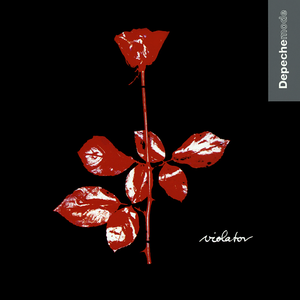
Depeche Mode Violator cover art.
DEPECHE MODE Violator (1990,) produced by Depeche Mode and Flood (Mark Ellis); engineered by Francois Kevorkian.
Depeche Mode’s Violator album represents a breakthrough for electronic music into the mainstream in a way that could only happen once. It is the culmination of not only the band’s evolution and rising profile, but also that of synth pop as a genre, and British synth music’s beginnings as an underground scene – influenced by orchestrated music, punk ethos, the proliferation of highways and the isolated shared experience of driving in cars, a new affordability and accessibility of synths, the fetishisation of machines and blurring of the line between machine and human, and an enduring love affair with dystopian, weird, dark, transgressive fiction.
This quote from J.G.Ballard’s Crash goes a long way to defining what transgressive fiction is: ““We live in a world ruled by fictions of every kind—mass merchandising, advertising, politics conducted as a branch of advertising, the instant translation of science and technology into popular imagery, the increasing blurring and intermingling of identities within the realm of consumer goods, the preempting of any free or original imaginative response to experience by the television screen. We live inside an enormous novel. For the writer in particular it is less and less necessary for him to invent the fictional content of his novel. The fiction is already there. The writer’s task is to invent the reality.”
This questioning of reality, and finding beauty in places where beauty should not be, and life and sensuality in objects that are not alive – in the weird, in the margins, in the wastelands – this aesthetic is mirrored in British synth pop songwriting. Because I’m all about music and literature being tangled together in pop culture and the collective unconscious, let’s follow that transgressive fiction thread from 1971 to 1990.
Electronic Music in Context
The Early 1970s – Wendy Carlos & A Clockwork Orange
1971 saw the release of a film that was for many their “gateway drug” into electronic music – Stanley Kubrik’s ‘A Clockwork Orange’ (based on the novel by Nathan Burgess, published in 1962). The film is set in a Dystopian Britain in what was then a near-future. The soundtrack [1]A Clockwork Orange Soundtrack, Wikipedia, https://en.wikipedia.org/wiki/A_Clockwork_Orange_(soundtrack) is a mixture of popular music, orchestral recordings, and some original electronic music and version-excursions of big dramatic Baroque and Romantic orchestrated and choral music, seriously arranged for Mini Moog by electronic music pioneer Wendy Carlos. The works re-imagined as electronica are – the title theme is an extract from Purcell’s Music for the Funeral of Queen Mary’, Rossini’s iconic ‘William Tell Overture’, the 2nd movement (Shertzo) and the monumental 4th movement of Beethoven’s 9th Symphony, the text being Frederic Schiller’s ‘Ode To Joy’, which is how this movement is often known. The lyrics [2]Fourth Movement, Symphony #9 Beethoven, Wikipedia https://en.wikipedia.org/wiki/Symphony_No._9_(Beethoven)#Fourth_movement are complex and conflicted – lofty, nihilistic, almost profane. The film is a lewd, violent, doomed tour de force through a fictional youth culture of Droogs. While it is difficult to imagine this now, the film was incredibly controversial, it was banned in the UK, and it was not allowed to be screened in the UK until 1999.
The Opening sequence “Clockwork Orange Theme” is a serious synth arrangement of Purcell’s Music for the Funeral of Queen Mary
By way of comparison, here is a traditional rendition of the same composition on authentic Baroque instruments.
It’s an austere March, composed in 1695 – for a quartet of ‘Flatt Trumpets’ which could play in minor key and were “similar to sackbuts or trombones.” [3]Reel, James, Henry Purcell: Music for the Funeral of Queen Mary, march and canzona for orchestra, Z. 860, All Music, … Continue reading Purcell is an interesting choice as he was a masterful composer of exquisite dissonances which can still sound tense, surprising and “very jazz” to our ears today. While Carlos doesn’t go down that road – using Moog synth is a radical enough new element to introduce into heritage repertoire in 1971 – the quality of the harmonic construction and the detail of the individual parts connects electronic music to heritage repertoire and serious orchestration in a very interesting relationship. The idea that Moog was “bringing back the Sackbutt” – well, while I am sure that was not on Robert Moog’s “to-do list”, there is an argument for hearing quite a lot of similarity between blatting monosynths and the timbre of monophonic early instruments.
While much of the film’s soundtrack album omitted Carlos’s score, Carlos released an album of the music in 1972 titled ‘A Clockwork Orange: Wendy Carlos’ [4]A Clockwork Orange: Wendy Carlos, Wikipedia, https://en.wikipedia.org/wiki/A_Clockwork_Orange:_Wendy_Carlos%27s_Complete_Original_Score This release featured many of Carlos’s own original compositions in entirety, and is a highly influential electronic music album.
The film also prominently featured British Brutalist architecture – the location was the Thamesmead Estate in Bexley; other Brutalist building in the film were the Lecture Theatre at Brunel University in Uxbridge, the Chelsea Drugstore, the “New House” in Shipton-Under-Wychwood, and the “Canterbury House” tower block of flats in Borehamwood. [5]Bolshy Flatblock: The buildings of A Clockwork Orange, Modernism in Metroland http://www.modernism-in-metroland.co.uk/blog/bolshy-flatblock-the-buildings-of-a-clockwork-orange The architecture is important as it is this hard stark Brutalist landscape that replaced war-damaged Victorian slums, and this Dystopian Science-Fiction as reality landscape had a profound influence on the British synth musicians. The connection made in ‘A Clockwork Orange’ between transgressive fiction, the urban landscape, and electronic music powerfully captured the imagination.
“That was probably a lot of people’s first time they had heard electronic music on the score to that film. It made me forever associate classical music with people getting their heads kicked in which is kind of a bit strange.” – Richard H Kirk, Cabaret Voltaire (Synth Britannia)
1977 – Warm Leatherette & J.G.Ballard’s ‘Crash’
Skip ahead to 1977 and it is two years after Kraftwerk had toured the UK for the first time, and three years after the release of their charting album ‘Autobahn’ which established a strong connection between the sound of electronic music and those other ubiquitous machines, cars! The song featured a Minimoog, an ARP Odyssey, an EMS Synthi AKS, and prominent use of vocoder [6]Autobahn, Wikipedia, https://en.wikipedia.org/wiki/Autobahn_(album) .
Britain has an underground sythpop scene kind of floating in the broader post-punk scene around Mancheter bands like Joy Division. There was OMD, The Human League, Cabaret Voltaire, and a guy in South East London named Daniel Miller. “I first got a synthesiser in 1977. I bought a secondhand Korg 700s from McHarry Music Shop in Charing Cross Road. The thing that pissed me off about punk is you had to learn three chords to be in a punk band, but if you had a synthesiser you had just to press one key with one finger. Do your best. If it’s crap maybe the synthesis will get you through” (Daniel Miller, Synth Britannia).
Miller was a fan of English author J.G.Ballard, and was particularly inspired by his novel ‘Crash’. The website Litreactor lists ‘Crash’ in their “Top 10 Transgressive Novels of All Time”. [7]Paul, Christophi, Lit Reactor, The Top 10 Transgressive Noovels of All Time, https://litreactor.com/columns/top-10-transgressive-novels ‘Crash’ is a Dystopian car crash fetish novel, as Miller explains, “I had just broken up with a girlfriend I was very much in love with and a friend of mine said, ‘Read this book.’ And I read it and it really had a huge – how do I not use words as puns – impact on me. It wasn’t like Science Fiction in that it was outer space and stuff, it felt like it was five minutes into the future and I loved that aspect of it that was so outrageous but so possible at the same time… [it’s] about people who have car accidents and find that their sexuality has been diverted and they’re obsessed and turned on by car crashes.”
This BBC4 Documentary from 1971 directed by Harley Cokliss with J. G. Ballard and Gabrielle Drake, gives a good insight into the novel’s themes for those that have not read it. “I’m interested in the automobile as a narrative structure, as a scenario that describes out real lives and our real fantasies. If the man in the automobile is the key image of the Twentieth Century, then the car crash is the most significant trauma … are we just victims in a totally random tragedy, or does it take places with our unconscious and even conscious connivance?” (J.G.Ballard).
The result of the “impact” of ‘Crash’ on Miller is the song ‘Warm Leatherette’ by his band The Normal. “The music is supposed to be visual like driving along a highway with big buildings either side and going into a tunnel. There’s quite a lot of humour in it really, it wasn’t meant to be apocalyptic or dystopian” (Daniel Miller, Synth Britannia).
“Trying to exhaust himself, Vaughan devised an endless almanac of terrifying wounds and insane collisions: The lungs of elderly men punctured by door-handles; the chests of young women impaled on steering-columns; the cheek of handsome youths torn on the chromium latches of quarter-lights. To Vaughan, these wounds formed the key to a new sexuality, born from a perverse technology. The images of these wounds hung in the gallery of his mind, like exhibits in the museum of a slaughterhouse.” – J.G.Ballard, Crash.
The link between these two increasingly affordable machines, cars and synths, and using them to traverse literal and emotional landscapes, was echoed again and again by electronic artists. It is telling that ‘Cars’ is the best known song by Gary Numan, who is known as “the first synth pinup” and he proved that synth pop could perform just as well as guitar based music in the pop music charts [8]Gary Numan Full Chart History, http://www.officialcharts.com/artist/17942/gary-numan/.
Gary Numan ‘Cars’ Top of the Pops, BBC1 1979.
“Cars is about feeling safe amongst people in a car. No one can get to you in your own little bubble” (Gary Numan, Synth Britannia). Cars was released in 1979 and reached No1 in the UK charts in 1979, and in 1980 it reached No1 in Canada, and No9 in the US Billboard charts and No9 in Australia.
Early 1980s, Mute Records & Depeche Mode
As it happened, Daniel Miller also founded the first electronic indie record label in 1978 – Mute Records. “I wasn’t interested in rock music. I was only interested in electronic music. I thought that was the future of where exciting music would come from and I wanted to be a part of promoting that” (Daniel Miller, Synth Britannia).
Depeche Mode formed in 1980 in Basildon, Essex. Their first album ‘Speak & Spell’ (Mute Records, 1981) was released on 5 October, 1981. The primary songwriter on the album is Vince Clarke. The album is named after a popular hand-held computer for children released in 1979 that included a the “Texas Instruments LPC Speech Chips” (TMC080 linear predictive coding speech synthesiser). [9]Speak and Spell [Toy], https://en.wikipedia.org/wiki/Speak_%26_Spell_(toy)
![Speak and Spell handheld device, Texas Instruments 1979. [Image: Wikipedia.]](http://www.acontrolroomofonesown.com/wp-content/uploads/2017/10/800px-Speak-Spell.jpg)
Speak & Spell handheld device, Texas Instruments 1979. [Image: Wikipedia.]
Within a year of realising their debut album, the band lost their songwriter, Vince Clarke who left to pursue a career in “fire and ice” electronic due Yazoo, with Alison Moyet on vocals.
Depeche Mode would quickly recover with Martin Gore stepping up to songwriting duties, although understandable still finding his feet. The next album A Broken Frame (Mute Records, 1982). The third single ‘Leave In Silence’ foreshadows the moody disquietitude that was to come in their evolution. Although classically trained pianist Alan Wilder was enlisted in 1982 as a live player for the A Broken Frame tour, he did not play on this album. A Broken Frame is considered one of Depeche Mode’s weakest albums.
The band sought to “toughen up” their sound with the next album, Construction Time Again (Mute Records, 1983) which is the first album to feature Alan Wilder working his arrangement magic. Martin Gore had seen Einstürzende Neubauten perform previous to going into the studio and the band became influenced by German industrial bands and began to get very seriously involved in making their own samples from found objects.Engineer Gareth Jones became really interested in recording room sounds, so everything on the album was basically “re-amped” to get a big sound and a real room sound. (It could be one of the reasons Depeche Mode’s third and fourth albums sound like they are over a nightclub PA in your living room, but turn to soup when played over a nightclub PA.)
The next album Black Celebration (Mute Records, 1986) was the same production team – Daniel Miller Producer, Gareth Jones engineer at Hansa Recording Studio Berlin – they had the idea to live and work together continuously, with no days off.
“Daniel Miller the record company boss and co-producer of the album had a vision too ‘live the album’ he described it as, he said, ‘right, I propose that we live the album, which means we are going to meet every day from the start of the album recording until it’s finished and we’re not going to do anything else’ and everyone thought, “Oh, that’s a good idea. Let’s do that.” I mean, it was a strong suggestion from him, he was like, What do you think of that?’ And everyone wen’t OK, that sounds about right and really wanted to do it, you know. So that’s what we did. So it made it very intense and it had enormous influence on the claustrophobic nature of the achievement.” – Engineer Gareth Jones (Depeche Mode, The Dark Progression).
While the album has incredible personality and is extremely industrial and creative – the “live the album” process was the end of that production team. The stand-out single from Black Celebration is ‘stripped’ which is built around a sample of a motorcycle engine slowed down – again, the continuing electronic music connection to those other dominating machines of our cities, the automobile. The song is also extremely morbid, lyrically.
‘Stripped’ video clip, from ‘Black Celebration’ 1986.
Alan Wilder – “We used to discuss beforehand how we were going to make each album different from the last. And that became more important to us as time went on, that we weren’t just going to repeat a formula.” (Depeche Mode, The Dark Progression)
Martin Gore – “Because we’d worked on three albums with Daniel and Gareth and we just felt we needed some fresh impetus, I also thnk that Daniel had ahd enough of working with us, because Mute by that time had started to become quite a big label, on the indie scene, and he had a lot of work to do anyway so spending months in the studio with us probably wasn’t an option for him.” (Depeche Mode, The Dark Progression)
They next album Music For the Masses (Mute Records, 1987) was produced by David Bascombe who had achieved acclaim working with Tears for Fears and Peter Gabriel. It was recorded in an old theatre in Paris full of old orchestral instruments which the band used for various sounds. The big single from the album was ‘Never Let Me Down Again’, which picks up on that electronic music preoccupation with cars.
Dave Bascombe – “Classic Martin, very simple chords and melodies he just seems to nail it. Same as Personal Jesus – it’s just great songwriting. This pop simplicity with this fantastic coating around it of big weird sound. That’s the success of it. When he’s on form I think he’s one of the best songwriters around.”
Dave Bascombe ”Alan’s an incredibly talented musician, he’s obviously the most musically trained out of all of them, and I think he’s had the most patience and vision in the studio. Martin really wasn’t interested in that particular side of it. Dave would be quite involved, but obviously Dave’s focus is the singing and an overview. Alan was pretty much doing every day stuff with me just every part wuld be layered up with the two or three different sounds so it was a quite painstaking thing and Alan had a good vision for that.” (Depeche Mode, The Dark Progression)
Depeche Mode’s Music for the Masses tour lived up to it’s name, and somewhere along the road they started to sell out stadiums, which was unprecedented for a synth band. The Rose Bowl final tour show in Pasedena was the biggest electronic show the world had seen – some 65,000 attendees – supported by Thomas Dolby and OMD.
Thomas Dolby – “It represented the zenith of the conquest of California and increasingly the rest of the America by DM – their sound and the tour that they did for Music for the Masses basically followed the infection of the Krock factor across North Amaerica to all the different radio formats and radio stations and I think they fed off each other each new city that they got tohad just dsort of got the bug of the Krock format – so it was very clear by the time that they got to the Rose Bowl which is the biggest gig that they’d ever done and really the biggest electronic music gig that had ever happened, it was gonna be a huge celebration, it was gonna be a kinda Woodstock for that electronic Krock sound.” (Depeche Mode, The Dark Progression)
Following this show, the band took time off from their grind of making an album every year, so it wasn’t until 1990 that they would release the next album.
Mark Ellis – Opening the Flood-Gate
For Volator Depeche Mode decided to work With “Flood” (Mark Ellis) and for the sake of this never-ending paper getting wrapped up, I will transcribe a chunck of interview from Short Circuit [available on YouTube thanks to SonicState] to summarise Flood’s history and approach, as he is something of an enigmatic figure in audio engineering:
“I started in the really old fashioned apprenticeship. I was a runner/tea boy at Morgan Studios in 1978 and I just worked my way up to assisting, then moved studios, did more running, then engineering, then moved studio again, and then assisting then engineering, then lots of engineering then production.” [Aside Note: Mark Ellis is famously known as “Flood” because there were two tea boys at Morgan Studios, and one was nicknamed “Drought”, and the other “Flood” as he was almost too enthusiastic in his duties.]
“I think I was very lucky because I started very young, I think I’d turned 18 by a week, so that meant I’d been doing it for two years by the time I was the assistant on the mixing of New Order. So in this day and age you’d probably be lucky if you were doing that by 25 or 26, so I think that’s where things were different and also I just worked insanely. Just sold my soul to the job.”
“You sort of have an inkling that something special might be happening about ¾ of the way through [an album], because you’re in a place where you’ve never been before. Very hard thing to describe. It’s not trying to be anything. It’s not trying to be it’s past or – it’s a very strange feeling and it’s not always the case but sometimes you have a feeling that you have done something that’s monumental.”
“I think [production is] as much about how you get on personality wise with people. You always when you meet up, people have aspirations or ideals, they – for instance last editors record – they wanted to have a change of direction and they felt I was the person to do it. Once you get in the studio you can have your own ideas and suggestions to move the thing along. It’s how you get on with each other. Other than necessarily me saying, ‘Right [with my clip board] you are going to do this now, this now.”
“To be quite honest I have a really really low boredom threshold. [Long evolving dance mixes] would be [his thing] if I’d been doing short punk songs of one and a half minutes. I could really get into it. That’s the way that I think. It’s like I’m bored of all that, right, let’s do something else. So that’s how I could go from Depeche Mode, to U2, to Nine Inch Nails, to Nick Cave, to Polly Harvey, and round the houses.”
“I only get involved in the projects where people want that opinion. It’s always I have to work collaboratively. It’s never my way or the highway. Nor do I like working with bands who say we’re gonna do it this way. So, why have you employed me? So it’s like an audio game of tennis. So they think they might want to change direction. It goes over the net to me. I will suggest a couple of things I think might help them. And then that will go back to them. And they’ll go back to that. And then they’ll go OK maybe we need to follow this direction…”
“Sometimes it just creeps up and you go: wow. Wasn’t expecting this.”
“I am still a hardware man. I have to say I find software, I find it quite limiting. Not all software – it’s such a generalization – but I’m a very tactile person and sometimes I find software that’s all of an ilk, tends to have a similar type of sound. I find that hardware stuff that gives you much more flexibility – I know we’re talking really small amounts, but the fact you can have six outboard compressors all of different makes, they all do something slightly different, and you can tell.”
“What I tend to do now is I work with people who deal with the computer for me. I tend to like working as if it were a tape machine. A number of reasons, some are sonic, some are the way if you start cramming loads of plugins over everything I tend to find most computers get really taxed and you start to get into grey areas of timing feel latency – and also I think it’s lazy. I’ve come from the school where one of the engineers taught me you’ve got all your output faders in a straight line and then YOU are getting the sounds and the balance is to tape. That any time you get the tape out, you put the faders in a straight line, it sound the same. I know from a couple of friends who mix all the time, they are just going, “Oh my God! Why can’t people RECORD the sounds instead of having all this slew of plugins over everything and the different machine, it’ll have different timing – you don’t know where you stand. Just commit!”
Violator & the Early 90’s Zeitgeist of Surreal, Dark & Weird
In the past Depeche Mode’s darkness and weirdness was too dark and weird for pop audiences – they had a dedicated audience in the Goth scene.
Violator’s status as such a successful album happened in the context of a year when Surreal, Dark & Weird were really popular. Transgressive Fiction that broke taboos went from the fringes to the mainstream with a succession of high profile works in the mainstream, notably the TV series Twin Peaks (1990-1991), Bret Easton Ellis’s novel ‘American Psycho’ (1991), the film adaptation of Thomas Harris’s novel ‘The Silence of the Lambs’ (1991) – dark and weird which had previously been the province of the art house and the pulp, was in the mainstream.
“Cooper’s Dream” Scene: Twin Peaks, Season 1 Episode 3: “Zen, Or The Skill To Catch A Killer”.
‘Silence of the Lambs’ Theatre Trailer (1991)
Depeche Mode’s Villator was released on the 19th of March 1990; David Lynch & Mark Frost’s Season One of Twin Peaks had screen debut starting April 8, 1990.
Violator: Track By Track
World In My Eyes – track one, single, video clip.
World In My Eyes features lush pads, beautiful reverb on both vocals, a sensual and danceable hard groove percussion and bass. Both David Gahan and Martin Gore sing, but Gahan takes the main vocals. The texture is really complex, with layer upon layer of synth parts, and then the effects on those parts adding an even richer dimension to the weave. The way it all interacts, the repetition is never quite the same. With the all the clarity of synths, it has an organic undulation, and is not mechanical sounding at all.
Sweetest Perfection – track 2
Depeche Mode Sweetest Perfection [10]Depeche Mode, Sweetest Perfection, https://www.youtube.com/watch?v=Zvx92CrYaRA
Sweetest Perfection is built around a shuffle synth/percussion loops, and big synth bass – there’s an organic feel to the groove, all the synth parts are played along. There’s an eerie use of cross panning. This song is quite Gothic with lush string pads and a simple guitar strummed for colour until the full groove drops in. I had to look up who sang this – Martin Gore – which I wouldn’t have picked. This is classic DM ballad of kneeling in the musical confessional, and gushing desperation and emotional clamour (which is what they do so well.) I would never wish contentment on these guys.
Sweetest Perfection Demo, from Sounds of the Universe, Depeche Mode [11]Sweetest Perfection Demo, from Sounds of the Universe, Depeche Mode , https://www.youtube.com/watch?v=fSwJYtDlkhg
Personal Jesus – track 3, single, video clip.
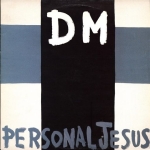
Personal Jesus Single – Depeche Mode
Personal Jesus – The ambling riff driving it’s simplicity, stompy percussion, and there’s that eerie open-sounding break to the rhythm. I love how the synth oscillations are timed with the bass part to form a groove, and the breathy samples, and the reverse delay on “Reach” is just gorgeous. This is the album where Martin Gore stopped merely writing his songs on guitar and started to play guitar on an album.
Probably the most defining element on Violator is the rhythm foundation for Personal Jesus – which is Fletcher and Flood stomping (or “jumping up and down”) on what I believe is a metal door and wearing Doc Martins or some similar substantial boots. It practically ambles or strides, rhythmically. (We are no longer in the safe bubble of Gary Numan’s car where no one can touch us!) This is such a metaphor for the change of direction the band wanted, and what Flood brought to the production – unlike ‘Stripped’ which is built around a sample of a combustion engine (again cars), Ellis had the band getting away from sounding “on the grid” [even though in the 80s they would have been mostly tracked to tape, their approach was “in the box” with samplers a lot], so instead of programming, sampling, chopping, comping and looping everything, there is a lot of live playing and playful things like “jumping up and down” on a mic’d up door. Violator still has a lot of “Depeche traditionl” production techniques – lots of sampling and looping – but that the is also part of the interest, the groove created between the mechanical portions and the bolder “one take” live performances. People take this stuff for granted today with performative electronic music technology like Ableton Live pe-packinging this hybrid process, but in 1990 pretty much no one was doing it. The fine scale graduation of human playing against the mechanical precision of very skilful sampling, and the exciting loudness and impact of something like jumping up and down in boots on a metal door, makes Personal Jesus so very exciting to the ears. It’s really brilliant and innovative pop music production, and a great example of how production, arrangement and songwriting can bleed together as creative processes, and how awesome the results can be when they do chiaroscuro in the studio.
Mark Ellis gave a presentation at the Short Circuit Mute Records Festival at Roundhouse in London, and at an event called Sound Edit in 2011. There are several crowd-filmed videos of this presentation on YouTube, and I have transcribed portions of the Sound Edit vids in two parts (all are worth watching, although the audio is not great on any of them).
From Short Circuit Presents Mute Festival (2011, London) Presentation by Producer Mark Ellis AKA “Flood”:
Personal Jesus
The distinctive beat – That’s the sound of me and Fletch jumping on a piece of metal. So we did this for about an hour and a half and of course the band are sitting there thinking, ‘Come on, what are you going to do? You’re the producer. This is hardly ground breaking.’ So we spent a lot of time getting it in time jumping up and down on a piece of metal. So what we did we started to record the sound of the room, put the footsteps through speakers in the room and record those and we ended up with… which is just the sound put through the speaker into the recording room, so the band are going ‘Oh, OK. We’ve heard this before. Come on, earn your money.’ So we move on to the other major thing which was there already which I think you’ll all recognize which is [plays twanging guitar amble’ – so that’s on an acoustic guitar and we spent a long time with Martin in the studio sitting there playing it over and over and over again until we got a loop that we thought that feels pretty good. But I said, ‘Surely you can just play this all the way through. You’re a brilliant guitar player, I know you’re a synth band, but why don’t we try and do something new. ‘
Martin – ‘Nope. Not having that.’
So we sat there and we looped it and we argued about what was the best bit and they went ‘this bit’ and I went ‘hmmm… OK’ so we looped all the sections of the song on the acoustic guitar. That took pretty much the rest of the day. And then when everyone was sort of happy I just said, ‘Well, why don’t you just try and play it through once on the electric guitar, just to add a little bit of excitement to it.’
So Martin got his guitar plugged it into the first amp that was there and played it through once and it sounded fantastic and that’s what behind the acoustic guitar and then in the final mix that tended to be the lead instrument rather than the acoustic guitar that we’d spent all that time looping. So strike one to me.
Because they wanted to do it in the old fashion way that they always did which was everything programmed – very very ridged – and one of the major things that I wanted to try and bring to Depeche was the idea that you can have – not feeling – but you can have real playing with electronics, so this was the first time that we started to actually approach that. He literally did this guitar part in one take. So that was the end of the first day, so everybody went ‘OK, let’s go out, let’s go drink…’
‘Oh, you’ve finally done something to earn your money. So that’s the drum pattern. It took about ten minutes normally you’d expect to take three days getting drum sounds and programming it but it was very simple and then after that we then started to move onto the bass and they wanted to try loads of different ideas with stacking bass sounds, so we’d start off and they’d say, ‘Oh, we really like the sound of a Jew’s harp.’ You know, ‘doing! Doing! Doing! Doing!’ So we got a synth sound and we spent quite a lot of time trying to get a synth sounding like a Jew’s harp, because we were trying to get the idea of it being blues but done electronically, so this was the first sound but it’s not that powerful, so then Martin suggested that we try using maybe a Moog, so that’s that recognizable part of the bass sound, and then somebody said well what about maybe a cello, so there’s a cello and a real bass guitar and they are all part of the overall sound, and again Martin played a bit of the bass but we sampled it all, and everybody sort of through that sounded pretty good. So that’s how the bass was made of all four elements.
So then we came to the other major part of the song that was already there from the demo which was the – [he mimes playing a guitar slide] – rawor – which everybody thinks is a slide guitar. And I said well I always thought on the original demo it sounded like voices, somebody going –RAOWRRRR! – and they all looked at me as though I was mad. But I said if we just combine the two sounds it’d be unique, it won’t just be a slide guitar, so everybody is looking at me as though I was going mad – and I said ‘Just like somebody screaming’ and Dave finally turned around and goes, ‘what like this? RAOOOWRRRR!” I went, ‘Yes! Exactly like that!’ So Dave went, ‘Alright then, sample this then. RAAAAOOOOWWWRRRRR!’ And I went, ‘Yep, that’s perfect.’ They were looking at me as though I was mad, but that is half of the sound that you hear when you hear the finished article. Again, strike two, producer. Slowly, I’m winning.
So that was pretty much all we did for day two. Out we go, partying away. Then we come back in next day, we start to do the famous breath and the breath came about because we wanted to do – we were trying harmonica – actually to do the bass part – and the sound just wasn’t right – but what we did like was the sound of someone going ‘inhales quickly’ and so we got a load of [inhales quickly] from Martin and I think Alan and chopped them all together and that’s makes up the [who-ha-ho-who-ha] from trying to get a harmonica for a bass sound.
The other major thing that we were trying to get was this feeling of it being more loose – or played – or organic – or all those rubbish words to describe moving them into a different place. So the other major thing was the way that they approached vocals and traditionally Dave would sing loads of vocals – as do most singers – and then you comp them – sit there and select the best bits – whereas my approach is one of let’s do three or four takes and then just what has the best feeling? And then we’ll take bits that are out of time or the performance is not great from one of the other takes and the band were really unsure about doing this. But to their credit that was the one song on all of Violator that we did by Dave doing three maybe four takes and piecing it together like that, which I think is one of the best vocals on Violator. But the band they have differing opinions about it. I think it gives all the energy to the track because it feels lively and it’s not totally chopped up as a lot of their music had been in the past. I think that and the electric guitar with the acoustic guitar are the things that give the track total drive total energy not from synthesizers.
The song was also highly controversial.
Depeche Mode ran into trouble during the promotional campaign for their new single “Personal Jesus”, with some regional newspapers refusing to accept ads for the record.
Both the Aberdeen Evening News and the Nottingham Evening Post rejected classified ads which simply featured the words “Your Own Personal Jesus” followed by a phone number which, when dialled, played the song, on the grounds that they may cause offence.
In London, the Evening Standard also raised objections due to the religious content, but later relented when representatives of the band pointed out that the paper had already run similar advertisements as part of Billy Graham’s “Life” Campaign.
The new single, the group’s first new recording for two years, is released by Mute on Monday.
It was produced by Depeche Mode and Flood and recorded at Logic Studios in Milan. The B side features “Dangerous” and an acoustic mix of “Personal Jesus”. Expect more remixes of the single to be released soon. All tracks were mixed by Flood and Francois Kevorkian, best known for his work with Kraftwerk.
Depeche Mode are currently in Denmark where they are putting the finishing touches to their as yet untitled new album, which should be in the shops early in the new year.
New Musical Express, 26th August, 1989
[12]New Music Express [NME], 26 August, 1989, Depeche Mode Media Files website, http://tiptopwebsite.com/websites/index2.php?username=depechemodefile&page=7
Halo – Track 4, single, video clip.
Halo has a much more industrial undercurrent than prior songs, referencing earlier DM efforts, with minimal but driving bass and a darkly uneasy detuned synth wail over the entire chord progression. There’s beautiful poetic painting, as Gahan sings the tender words ‘fall into my eyes’ he’s accompanied by an ascending scale in big strings. Decedent vocal harmonies placed behind the main vocal crescendo and move forward dramatically after a prolonged, controlled slow crescendo as the texture builds. Lush, dramatic string pads and/or real strings provide Gothic icing on the cake.
Halo Demo by Depeche Mode [13]Halo Demo by Depeche Mode, https://www.youtube.com/watch?v=cDdzX7-odoU
Waiting for the Night – track 5
Depeche Mode, Waiting For The Night [14]Depeche Mode, Waiting For The Night, https://www.youtube.com/watch?v=vyrpRzdvp5U
Waiting For The Night features a lovely little two note tap-delay pitter-patter of harmonics. (I’m sure this has been sampled by VNV Nation, who aren’t half as clever with it.) The texture is made more solid with a djembe-like bass synth, and ethereal backing vocals. The chorus features a nice synth ostinato, and a woodwind synth part that is so suggestive of the actual instrument you wonder if it’s not a real oboe. The simple layering of parts broadens out with a modulation, deepening and adding treble parts, leaving room for the vocals in the centre. Vocals sound like they might be double-tracked. There’s tasteful gated reverse delay on the guitar, and tap delay on an almost sub-sonic bass, moving to a sinuous serpentine break, then back to the original tap with a soft wash of synth oscillations – this would sound devastating on a good club PA. The ‘aaaah’ backing vocals sound androgynous, and the intervals sound almost Byzantine. There’s a huge undercurrent of darkness, but it’s not hammed-up, the musical shadows just fall naturally which makes it more powerful.
Waiting For The Night studio production sketch version, Martin Gore and David Gahan [15]https://www.youtube.com/watch?v=_prY01lZYE4
Enjoy The Silence – track 6, single, video clip.
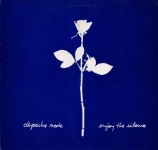
Enjoy The Silence single – Depeche Mode
Enjoy The Silence is possibly Depeche Mode’s most iconic song. Flood gave a presentation at the Short Circuit Mute Records Festival at Roundhouse in London, and at an event called Sound Edit in 2011. There are several crowd-filmed videos of this presentation on YouTube, and I have transcribed portions of the most complete one (all are worth watching, although the audio is not great on any of them).
From Short Circuit Presents Mute Festival (2011, London) Presentation by Producer Mark Ellis AKA “Flood”:
“In the demo Martin’s playing a little pump organ … Daniel and Alan Wilder both suggested that maybe it could be an up-tempo disco song. Martin was really unsure about this. We didn’t record it in the first session in Milan, after Milan – a lot of drinking, trying to break me – and completing Personal Jesus, we then had six weeks off and then we went to Denmark. To Puk Studios. Which is in the middle of nowhere. There was nothing to do except make music. So we got to Enjoy The Silence and and Martin was going ‘I really don’t think it wants to be a disco song.’
I’m going, ‘Martin, trust me. It’s been going well, hasn’t it?’
‘Oh, yes.’
‘Let’s try. Let’s experiment.’
‘I really don’t think it’s going to work.’
So Martin went off, he went to his room basically, for the first day while we were doing it. And myself and Alan sat in the studio – so how are we going to make this into a disco song?
Well, the easiest thing is to get a track that you like and copy it. So, we got a certain track and we copied it. And we started off with the drums … so we started off with the basically copying these drums which are some of them are actually lifted from the original song – I shouldn’t say that, but I just did. So and then that’s just a copy of this track – so I think Dave and Fletcher had gone home for the weekend, Martin’s sitting in his bedroom, grumpy, and me and Alan are sitting there in the studio so and I’d recently bought a big modular Rode synthesizer and I’d been playing around with it, and Alan said, ‘Oh, how does this work?’ And I said you do this and you do this. And he started playing around and said well shall we try and do a bass sound? And I said, well here’s a bass sound – here’s the sequencer – and he started fiddling around with it, and that’s how the bass line came, so that’s just a sequence on the System 700 which is a big modular synth, and he said, well can you change it, and I said, ‘Yeah, that’s easy.’ So this is sounding pretty good.
But, Martin, no, not interested at all. So we said, ‘Well, OK, Martin, we do need a melody. A strong theme.’
So he said, ‘Oh, yeah, all right.’
So he comes out and on the worst sounding synthesizer with the worst sound ever he plays – plonks out theme –
Brilliant! Brilliant!
Really?
Yes! Yes! Yes! But not on that sound!
Let’s try a guitar.
‘No, I don’t want to play guitar any more. There’s far too much guitar on this record already.’
‘Just try it. Just trust me, Martin. Just trust me.’
So he sat there. ‘Well I don’t want a normal guitar sound.’
Well look, we’ve got this new FX thing, let’s put it through that.’
‘Just get a good sound.’
And he’s just so not into it. But he sits there and he plays that riff. Just two takes. And straight off. And I mean it’s not the most earth shattering guitar sound but at that moment and at that time just putting it through one processor – it was a bit of flange or chorus – made him feel comfortable, and he just played it. And then he left. He went back to his bedroom. ‘I don’t like it at all.’
‘OK Martin, just give us one more day – that’s all I’m asking – and then if you really don’t like it and everybody else thinks it’s a waste of time, then fine. We’ll do it your way.’
‘OK.’
So he went off and me and Alan carried on and we did most of the rest of the music – the strings – the choir sound – and then the strings answering it – and then Dave came back and he did the vocals and it was pretty much done in two days.
Martin – ‘I really don’t like it.’
But Daniel had also come over just about the day after we’d finished doing the basic recording, and he sat and heard the progress – Mr. Record Company coming in to check up on us and make sure that we were working – so he listened to a load of tracks and I’d done a rough mix of Enjoy The Silence which I thought was pretty good and it was the end of the second day and Daniel heard it and just went ‘Amazing! It’s gotta be a single. That’s fantastic.’
Martin ‘I really don’t like it.’
So everybody else – Dave, Fletch, Alan, Daniel – and a few other people who heard it loved the track. We go back to London after being in Denmark for six weeks and we finish off doing the brass in the middle and a couple of extra bits of vocals and we’d finished the song and Francois Kevorkian had come in, he’d mixed the whole album, and it was all great, but Martin just went ‘I really don’t like Enjoy The Silence.’
We’re looking at him, ‘You’re mad, Martin.’ But he didn’t like that version of the song at all, but to his credit he wanted it to go on the record and it did. But Daniel wasn’t happy with the mix of it. So we had to go into another studio with a completely different engineer and mixer and we sat in the studio for three days copying the rough mix that I’d done in Denmark on a cassette sitting there [pretends to push fader] no, just play the cassette with the rough mix, and that’s what the final mix is. Which is quite ironic really we could have just used the cassette.
So that shows how different the approach was to two different tracks. One was pretty much as they would have expected it and had been used to doing, and just a re-working of the demo, but the other song was totally nothing like they’d done before and it was done so quickly cause traditionally always Depeche always did a week or two weeks on a song, endlessly programming, sampling, doing little bits, but Enjoy The Silence was three days at the most to do the whole song – the bulk of the song was done in one day. For me it was very informative and a great learning experience, working with that band, because once everybody had relaxed it was a chance to try anything. There was nothing that we didn’t try on those sessions. Drumming. Full drum kits. Even had all of Depeche Mode playing as a rock band. Fletch on bass, Alan on drums, Dave singing, but Martin playing this heavy electric guitar and all of those things got used somewhere along the lines on the sessions.
Enjoy The Silence – Demo by Martin Gore. [16]Enjoy The Silence Demo, Martin Gore, https://www.youtube.com/watch?v=uL4epbvM8oY
Policy of Truth
Policy of Truth music video, Depeche Mode
[17]Policy of Truth music video, Depeche Mode, https://www.youtube.com/watch?v=M2VBmHOYpV8
Policy Of Truth features another great bass line, kinda Motown, over which roll eerie sweeping oscillations, and an ambient industrial soundscape. There’s a gorgeous crescendo of guitar wail and saw-wave synth together. The lyrical power in this song is not in the singers righteous and confidant anger, but in vulnerability. We hear his hurt, and also his deepest self-reproach. In a brilliant musical representation of setting and psychology, the singer is buffeted and almost overwhelmed by the synths.
Blue Dress
Blue Dress features a more airy rendition of Gore’s voice. There’s a lovely change when a harp/pitz synth sound changes the groove to feel faster with subdivisions, although the metre remains the same. Texture completely opens out for vocals and guitar on ‘Cause then you’ll learn, you’ll know what makes the world turn…’, followed by cyclic loops layered many times over, each of a different length, creating a rich texture and a musical representation of ‘turning.’
Blue Dress, Depeche Mode
Hidden Track – Interlude
Interlude (hidden track following Blue Dress on Violator)
Demo of Interlude
Clean
Clean features very Gothic woodwind samples, and an entire androgynous choir of Martin Gore. Sirening oscillations blend with the woodwind and ambient crunch distorted sounds, the medieval sounding ‘choral’ group swelling with the entry of a galloping two note synth bass. This folksy cowboy lilt is reminiscent of Ennio Morricone’s spaghetti western scores, an effect enhanced by pan pipe. The industrial steam-piston percussion with shifting emphasis. Rolling rumbling toms echo The Cure’s experimental drumming on Pornography.
The simple framework that Martin Gore usually writes on guitar is very well exemplified in this acoustic version of clean live in the studio.
Depeche Mode Clean acoustic studio performance
Clean, Depeche Mode
[18]Clean music video, Depeche Mode, https://www.youtube.com/watch?v=h1mD-_DKHc0
Depeche Mode are beautiful, and on Violator they reveal themselves with honesty. I hear this music and my heart leaps.
Demo version
Clean Demo by Depeche Mode, from Sounds of the Universe
Alan Wilder – Master Electronic Music Arranger
Alan Wilder is undisputed as the sampler and synth arrangement genius in Depeche Mode, who took the songs as sketched by Martin Gore and. as Thomas Dolby put it “orchestrated on synths in a really serious way”. (He also served as full kit drummer for the band from 1993, which he learned the drums for.) Alan Wilder actually used to be a Tape Operator at age 16-17 in the studio for DGM Records, he was a skilled tape editor, and he worked on albums for The Rubbettes, and he was asked to play keyboards for them (his first studio recording).
Depeche Mode made extensive use of “found sounds” – samples they created themselves – and they made full use of the capabilities of samplers of the mid-to-late 1980s to create performative sampler arrangements; this would consist of layering all the parts for a song across a number of samplers so that the song could be performed by the band. The sampling would include studio sounds such as vocal layers and instrumental samples (e.g.. Martin Gore playing e-Bow), as well as sound made electronically in the studio and rendered with studio effects such as delay and reverb, so the live performances had the integrity of the full-scale sounds used on the albums.
Alan Wilder auctioned a lot of his Depeche Mode gear online in 2011, and the four promotional videos from that auction are still online. They provide an amazing insight into the Depeche Mode’s gear as well as the history of the band. This includes the custom-made in ear monitors, multi-track tapes, and synth and sampler instrument discs.
Alan Wilder Collected 1 auction promotional film 1
This film features acetates and test pressings, as Alan Wilder was the band member who attended the acetate and test pressing review sessions.
Alan Wilder Collected 2 auction promotional film 2
The extent to which Wilder was involved in this is very well demonstrated in his “auction promotion video” for the E-mu EMAX II loaded with Depeche Mode live sound arrangement sample libraries for each song.
Gear – Synths & Samplers
Depeche Mode’s Stage Plans for their 1986 Tour list the following gear inKeyboard Magazine, October 1986.
Alan Wilder, stage right: E-mu Emulator II atop Kord DW-8000.
Martin Gore, stage centre: PPG Wave 2 atop E-Mu Emulator II.
Andy Fletcher, stage left: Sequential Prophet 2000 atop a second Prophet 2000.
Additionally, Wilder, Gore and Fletcher each play custom built percussion instruments through contact mikes, which trigger sampled sounds from an Akai sampler via a Roland Octopad.
[19]Doerschuk, Bob, The Wilder Side of Depeche Mode, Keyboard Magazine, October 1986
E-Mu Emulator II
The E-mu Emax synths were a major part of Depeche Mode’s electronic music set-up from the mid 80s and into the early 90s, and the specs are described as follows at Vintage Synth Explorer: “The Emax features many common analog synth-type controls … tune, filter and shape the envelope or use LFO’s and chorus to liven up your samples. There’s also an on-board sequencer section. A real-time only 16-track, non-quantizable sequencer for basic scratch-pad use or simple arpeggios or patterns … The Emax II which was released in 1989 brought the Emax series up to modern specs with 16-bit sampling, 16-voice polyphony, 16 MIDI channels, stereo samples, 1MB RAM expandable to 8MB, SCSI, 8 assignable outputs and the SE’s synthesis functions”. [20]E-Mu Emax entry, Vintage Synth Explorer, http://www.vintagesynth.com/emu/emax.php
Emulator II “Shining Moments” clip (including Ferris Bueller’s fake coughing) and a truckload of Depeche Mode Emulator II moments
Further Viewing
Soundcheck with Alan Wilder
References
| ↑1 | A Clockwork Orange Soundtrack, Wikipedia, https://en.wikipedia.org/wiki/A_Clockwork_Orange_(soundtrack |
|---|---|
| ↑2 | Fourth Movement, Symphony #9 Beethoven, Wikipedia https://en.wikipedia.org/wiki/Symphony_No._9_(Beethoven)#Fourth_movement |
| ↑3 | Reel, James, Henry Purcell: Music for the Funeral of Queen Mary, march and canzona for orchestra, Z. 860, All Music, https://www.allmusic.com/composition/music-for-the-funeral-of-queen-mary-march-and-canzona-for-orchestra-z-860-mc0002359401 |
| ↑4 | A Clockwork Orange: Wendy Carlos, Wikipedia, https://en.wikipedia.org/wiki/A_Clockwork_Orange:_Wendy_Carlos%27s_Complete_Original_Score |
| ↑5 | Bolshy Flatblock: The buildings of A Clockwork Orange, Modernism in Metroland http://www.modernism-in-metroland.co.uk/blog/bolshy-flatblock-the-buildings-of-a-clockwork-orange |
| ↑6 | Autobahn, Wikipedia, https://en.wikipedia.org/wiki/Autobahn_(album) |
| ↑7 | Paul, Christophi, Lit Reactor, The Top 10 Transgressive Noovels of All Time, https://litreactor.com/columns/top-10-transgressive-novels |
| ↑8 | Gary Numan Full Chart History, http://www.officialcharts.com/artist/17942/gary-numan/ |
| ↑9 | Speak and Spell [Toy], https://en.wikipedia.org/wiki/Speak_%26_Spell_(toy) |
| ↑10 | Depeche Mode, Sweetest Perfection, https://www.youtube.com/watch?v=Zvx92CrYaRA |
| ↑11 | Sweetest Perfection Demo, from Sounds of the Universe, Depeche Mode , https://www.youtube.com/watch?v=fSwJYtDlkhg |
| ↑12 | New Music Express [NME], 26 August, 1989, Depeche Mode Media Files website, http://tiptopwebsite.com/websites/index2.php?username=depechemodefile&page=7 |
| ↑13 | Halo Demo by Depeche Mode, https://www.youtube.com/watch?v=cDdzX7-odoU |
| ↑14 | Depeche Mode, Waiting For The Night, https://www.youtube.com/watch?v=vyrpRzdvp5U |
| ↑15 | https://www.youtube.com/watch?v=_prY01lZYE4 |
| ↑16 | Enjoy The Silence Demo, Martin Gore, https://www.youtube.com/watch?v=uL4epbvM8oY |
| ↑17 | Policy of Truth music video, Depeche Mode, https://www.youtube.com/watch?v=M2VBmHOYpV8 |
| ↑18 | Clean music video, Depeche Mode, https://www.youtube.com/watch?v=h1mD-_DKHc0 |
| ↑19 | Doerschuk, Bob, The Wilder Side of Depeche Mode, Keyboard Magazine, October 1986 |
| ↑20 | E-Mu Emax entry, Vintage Synth Explorer, http://www.vintagesynth.com/emu/emax.php |
This project was undertaken as coursework for assessment in the ‘CUASOU503 Develop Sound Designs’ Unit of Competancy, as part of the Advanced Diploma of Music Industry qualification at Melbourne Polytechnic.
The UnVoice In Campus Sounds
For this project we needed to create a Sound Installation in Ableton using “campus sounds” framed by a concept, narrative, idea or theory. I decided to play with the notion of the voices of the campus – including the UnVoice or the Uncanny Voice of the campus, with a speculative fiction idea of voices of the place (a former hospital) resonating both forwards and backwards in time – ghosts of the future and ghosts of the past.
In her book ‘Voicetracks: Attuning to Voice in Media and the Arts’ (MIT Press. Cambridge, Massachusetts, 2017.), sound artist and academic Professor Norie Neumark poses the idea of the unvoice, of unvoicing, of being unvoiced. (My WordPress autocorrect keeps changing the words to unveiled and unveiling, which is poignant to the visibility of women.)
“The figure unvoice … particularly speaks to me because it evokes an … un quality of voice, its uncanniness – the return of the undead? As writer and scholar Mark Fischer, aka k-punk, points out, the Derridean figure of haunting and the uncanny (unheimlich) resound together: “Haunt is a perfectly uncanny word, since like ‘unheimlich’ it connotates both the familiar-domestic and its unhomely double. Haunt originally meant ‘to provide with a home,’ and has also carried the sense of the ‘habitual’ (k-punk, 2006). In this sense, unvoice literally haunts its media, a reminder of how we habitually used to listen to a relationship that is no longer at ease here – uneasy as well as uncanny.” [1]Neumark, Norie. ‘Voicetracks: Attuning to Voice in Media and the Arts’, MIT Press, Cambridge, Massachusetts, 2017.
For my Sound Design Installation I decided to play with the permeable nature of memory and time and the notion of extra-sensory perception of the dying or the delirious and feverish and deeply troubled. While echoes of the past linger in the architecture – the quiet sad dereliction of the Aids Memorial Garden with the river bush sounds, the theatre that looks awfully like a crematorium and a morgue space, the awnings and doors clearly designed for ambulance use, the hospital squeak of the floors and the high gates with a gatehouse to secure every infectious patient from making a quite literal “outbreak” – and fill the present with reminders of mortality – what if these resonances also echoed backwards? The voices and music and overlapping din of practice rooms and studios and rehearsal spaces echoing back to the minds of the dying and fever-drenched who used to occupy these buildings?
A Sense of Place
Melbourne Polytechnic Fairfield Campus, where many of the music and sound production courses are based, is a beautiful campus set in seclusion and surprising isolation given the inner-suburban location. This is not an accident. The campus is the former location of the Fairfield Infectious Diseases Hospital, originally the Queens Memorial Infectious Diseases Hospital. The location between Merri Creek and the Yarra River creates natural barriers; one can only approach the campus on one road (unless using a bike or walking trail).
While there have been obvious efforts to mute the “institutional” hospital feel of the campus, at every turn in the architecture and fixtures (or places where fixtures used to be) the medical nature of the history linger. This creates a peripheral awareness of very different uses of the spaces, both in the comparative recent history in the 1980s and 1990s when HIV/AIDS research and treatment was a major undertaking at this facility and the title “Queen’s Memorial Hospital” was owned humorously by the community of patents [2]Fairfield Hospital, Under The Red Ribbon, http://undertheredribbon.com.au/vignettes/fairfield-hospital/ , and further into the distant past – from the Polio epidemics of the 1920s to 1950s, right back to the Spanish Infuenza epidemic of 1918.
People convalesced on the sheltered verandahs here. And people died painful deaths here. And people lingered in altered states of delirium and fever-dream. Right next door to this day, the southern part of the original hospital is still in use as The Victorian Institute of Forensic Mental Health, Thomas Embling Hospital – which treats the acutely mentally ill from the criminal justice system. There is a sense of over-lapping and parallel narratives, where very different modes of perception are unfolding.
And then there are the music students today filling the rooms and the outdoor environments with music and sound, overlapping different eras, echoing, resonating…
Source Recordings
I collected a range of different location recordings on campus, wondering about with a Tascam DR-100MKII Linear PCM Recorder and a Sennheiser ME66/K6 Supercardiod Shotgun microphone. The sounds I recorded included cafe sounds, sounds of the factory next door, traffic sounds on Yarra Bend Drive, sounds of the hospital-fitted air-conditioners, sounds of birds and of brushing past plants, sounds of horticulture students digging and shovelling, sounds of various rehearsals from the exterior of buildings (including Gamelan Ensemble, Georgian Choir, rock and pop ensembles). I also sourced sounds from studio recordings I had made within the campus, but made new and uncanny through processing – I made particular use of AudioSuite in Pro Tools 12 to process audio backwards. This was especially uncanny sounding on the Georgian Choir and Gamelan Ensemble recordings. The ideas of these inter-cultural sounds echoing back to a distant past where they had little context to frame them to ghosts of the past was a particularly romantic, ethereal and numinous notion.
I also included recordings of my own voice singing select phrases from the ghost ballad ‘The Unquiet Grave’ as I found it quite applicable to the theme and concept of Unvoice and Uncanny Voice, as well as the history of the Campus: how much human remains must linger in a place for it to be a grave? After attending Liquid Architecture/ the Melbourne International Film Festival event ‘Michel Chion: The Audio Spectator’ [3]Liquid Architecture, Michel Chion: The Audio Spectator, http://www.liquidarchitecture.org.au/program/michel-chion/ , and seeing and hearing how much of himself Michel Chion put into his sound art, I felt quite liberated to be a part of the work as one of the voices. I found the phrase “grow green, and spring up again” to be very evocative of the lushness of the carefully tended gardens here, and the creepy idea of voices or unvoices rising up like ghosts.
Initial Assemblage of Sound Collage
As I feel very “newb” and not skilled up in Ableton, I arranged elements and did some processing in Pro Tools 12, before exporting stems for import into Ableton.
MP3 of Partial Project, audio elements compiled in Pro Tools.
Constructing Instrument Rack and Drum Rack in Ableton
I then assembled my stems again in Ableton (this was only a partial success, due mostly to my still tentative skills using Ableton). The following two screenshots are of Ableton Session View of audio elements.
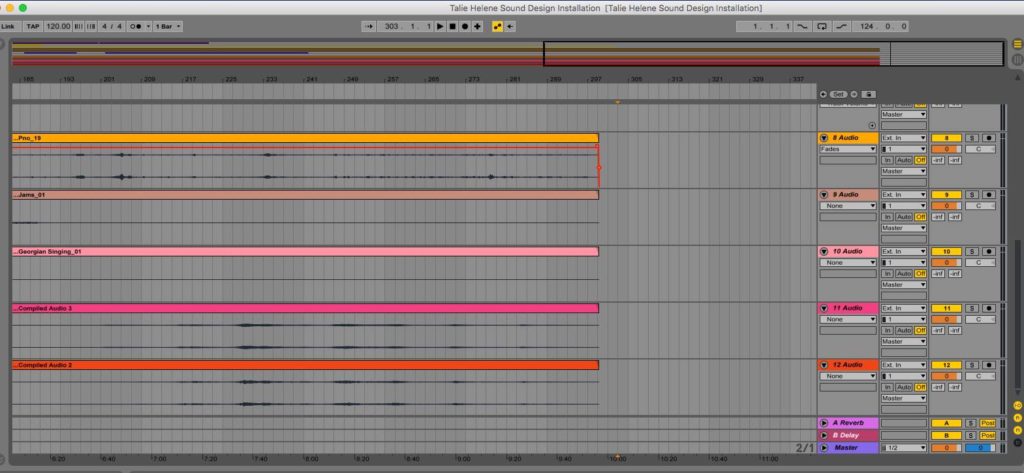
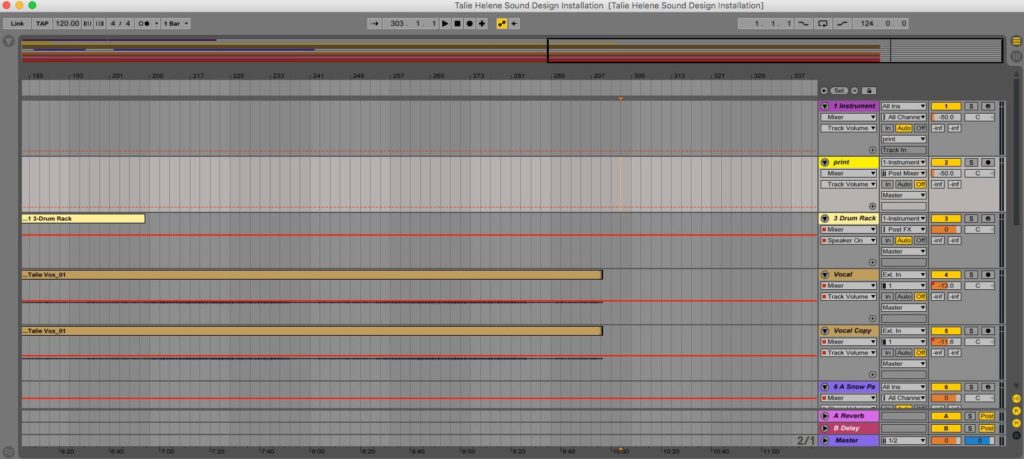
I created both an Instrument Rack and a Drum Rack as per our assessment brief requirements. I used the audio of various Campus Sounds elements from a Clip Library of original Sounds instead of “Loops” included with Ableton.
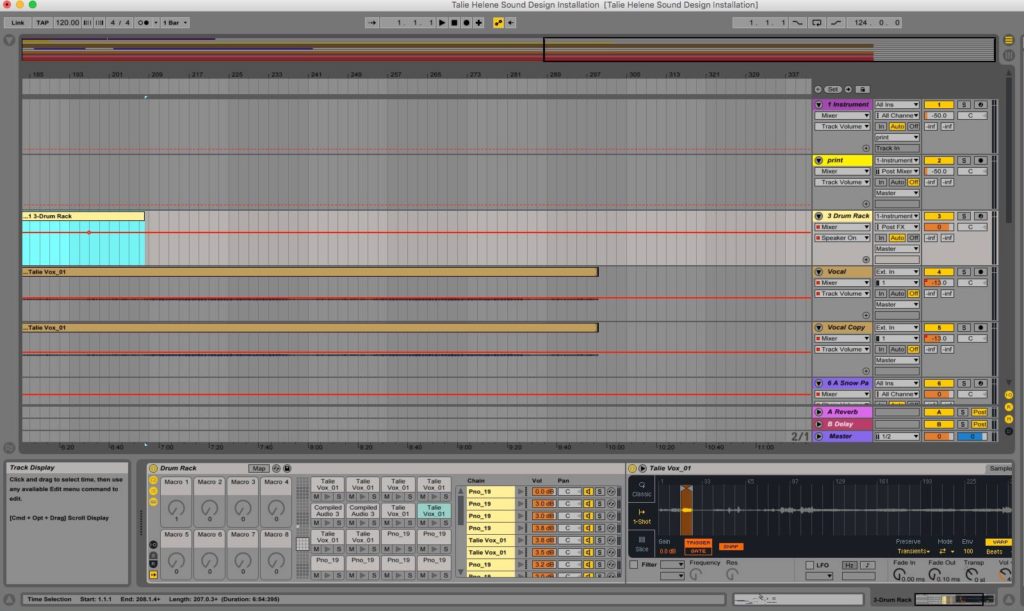
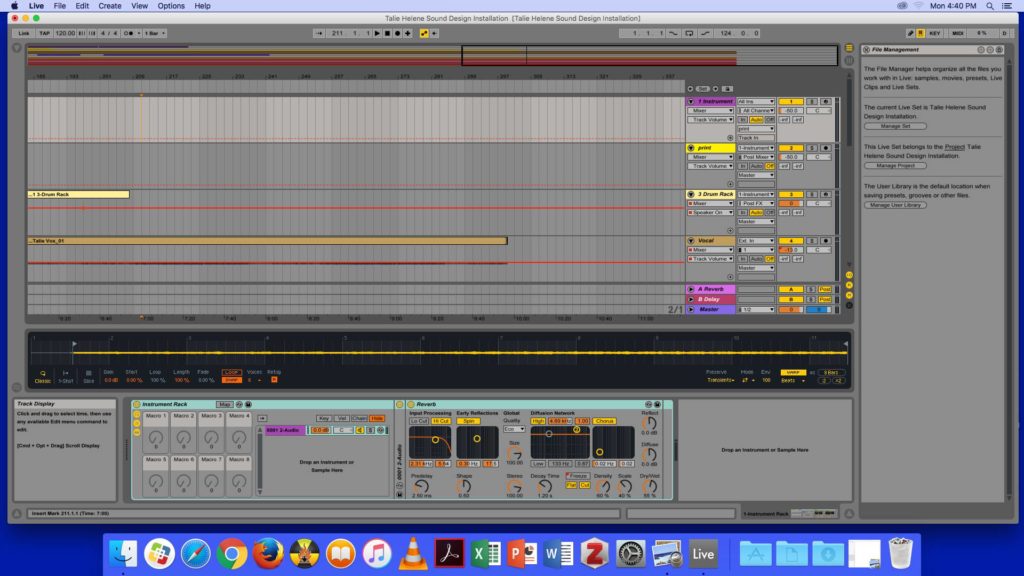
Once I had created the Instrument Rack and Drum Rack and included some processing, I played both of these “Live” and recorded the audio. This gives the Sound Installation a spontaneous and improvised quality. I very much treated this as an experiment, as I am learning about Ableton as an “instrument” each time I use it.
Unvoices of Yarra Bend
MP3 of final project:
In De-Brief
I did become slightly more proficient in using Ableton during this project, although I still identify many aspects where I am struggling to achieve even the most basic tasks of placing audio on a track (and Google the problem and get unhelpful advice or tutorials that require use as an Admin). It makes it hard to differentiate actual problems from mere logistics problems of using a lab computer, and I have not got a solid grasp of “Ableton 101” basics. For this reason, I applied to (and was accepted into) the Operator [4]Operator Event page, Arts Centre Melbourne, https://www.artscentremelbourne.com.au/event-archive/2017/the-channel/operator-ii short course at Arts Centre, which is affiliated with the Melbourne Ableton User Group. I have only attended one Operator class so far, but I am already beginning to appreciate some of the features that make Ableton unique – which also make it confusing and cumbersome if you come at it with the expectation that it is going to function like another DAW. I look forward to how my skills will be enhanced by taking a course more focused on basic Ableton operating skills, and where this may take my creativity in the future…
References
| ↑1 | Neumark, Norie. ‘Voicetracks: Attuning to Voice in Media and the Arts’, MIT Press, Cambridge, Massachusetts, 2017. |
|---|---|
| ↑2 | Fairfield Hospital, Under The Red Ribbon, http://undertheredribbon.com.au/vignettes/fairfield-hospital/ |
| ↑3 | Liquid Architecture, Michel Chion: The Audio Spectator, http://www.liquidarchitecture.org.au/program/michel-chion/ |
| ↑4 | Operator Event page, Arts Centre Melbourne, https://www.artscentremelbourne.com.au/event-archive/2017/the-channel/operator-ii |
This project was undertaken as coursework for assessment in the ‘CUASOU503 Develop Sound Designs’ Unit of Competancy, as part of the Advanced Diploma of Music Industry qualification at Melbourne Polytechnic.
Preamble
This blog post constitutes the presentation of the project; this mode of presentation is my preference over an in class presentation, as I wished to address issues that arose over the course of undertaking the project that would be difficult and stressful to consider in a verbal mode, and are more coherently addressed with the critical distance provided by a written and media presentation online. If you would like to leave a comment on the blog, you are welcome to do so.
Project Brief Summary
For this Audio Tour Project the students were given only one script to chose from to produce. The script that had been produced is a story about men, written by men, which includes the names of men, and the voices of men. The gender of the narrator is not specified in the brief, or the script, or the audio elements list. It is a violent colonial story that features only white men. I recommend that in future a number of scripts be produced for the students to chose from, that includes narratives that feature women and people from non-white colonial backgrounds in the stories, as this potentially alienates students from the project and it limits the voices that might be realistically employed in the production. If students have experience in writing for media and/or performance, I would suggest the student have an option of authoring their own script. (For example, I have trained in writing for radio with Steve Wheat, screen writing with Cathy Johnstone, and performance writing with Barry Dickins, and as such, I very likely may have more specialised expertise in this area than the teachers who created the script I am obliged to work from.)
The Project Brief
“Tourism Victoria is hosting an exhibition on the life of Ned Kelly at Glenrowan, in rural Victoria. As part of the exhibition, a sound design piece is to be implemented as a key element of the live event experience. As Tourism Victoria hosts a series of guided tours throughout the calendar year, the aim of this special event is to further enhance the regular ‘walk and talk’ guided tour by making it a more interactive experience for tourists. For this special event, a script has been produced, which contains 14 elements in total.
The sound design piece will be activated by tourism staff at the beginning of the ‘walk and talk’ tour. This will assist in ‘transporting tourists back in time’ and adding a touch of drama to the experience. Once played, the tour guide will lead tourists on a journey around the famous local landmarks where the actual events occurred. Your job is to sonically re‐create elements of the battle that took place between The Kelly Gang and the Police in Glenrowan. A combination of voice over narration and specific sound components have been chosen to best achieve this as a sound design piece. These will need to be assembled and mixed as stereo audio files in a DAW program.
Tourism Victoria staff will activate the playback of the sound design piece from a laptop at the exhibition site in Glenrowan. They will employ a stereo speaker set up for the installation at the venue. The event will incorporate lighting and image projection to further enhance the experience. These elements will be curated by the staff once the sound design is complete and delivered.
Consultation with your lecturer will be required to implement a successful sound design.” [1]Assessment 1 BRIEF, Created by Greg O’Shea, Martin Koszolko, February 2016, @Melbourne Polytechnic 2017.
Mock Client “Creative Director”
This project was designed with a very great deal of control and input given over to the teacher: “Your teacher will act as the ‘client’—as it were, a Creative Director. The Creative Director will have final approval over all elements of the sound design, including the voice talent and the recording of the script.”[2]Assessment 1 BRIEF, Created by Greg O’Shea, Martin Koszolko, February 2016, @Melbourne Polytechnic 2017.
The project specified that two voice-over artists needed to be sourced and recorded in “studio conditions” – this entailed “a quiet room and with a quality microphone. You may use additional signal processing, such as equalisation and compression.”[3]Assessment 1 BRIEF, Created by Greg O’Shea, Martin Koszolko, February 2016, @Melbourne Polytechnic 2017.
Voice Over Artist Recording & Production
The voice over of narrative for this Audio Tour is hands-down the most important auditory element. I extracted the text from the script so that it was presented as narration text only, in standard prose format of sentences and paragraphs with full punctuation. This was easier and more natural to read than the script, which was presented with all the audio element cues, both narration and sound design in a linear workflow.
I made a short booking at Toyland Recording Studio in Northcote, where I do some work as an intern engineer, and also communications and studio operations support work. I could not afford to pay a professional voice over artist for this project (although they frequent the studio often, as the studio produces many media productions for radio and other delivery formats.) Due to studio availability being limited (it is a working production facility), and the short length of the narration (less than one page), it was more efficient and achievable to record the entire voice overs with two contrasting voices – rather than record two partial voice overs and necessitate a second booking to re-record one of those in entirety.
Technical Specifications for Voice Over Recording
The studio “Room A” tracking room is quiet and has professional diffusion and reflection acoustic treatments to control the behaviour of sound waves advantageously for recording. The script was placed on a music stand with sconce light. The voice over artists wore fully enclosed headphones.
The microphone used in both voice overs is a Neumann m149 Tube Variable Duel Diaphragm Condenser microphone [4]https://www.neumann.com/?lang=en&id=current_microphones&cid=m149_description set to Cardiod Polar Pattern. The microphone was mounted on a (beautiful vintage) extra tall broadcast fixed boom stand, with plosive filter.
The signal flow was:
- Neumann m-149 Tube Condenser microphone >
- to Neve 1084 (1073 Mic Pres with expanded EQ sections) Pre-Amp >
- to Urei 1176 (Original – black front plate) mono limiter for Compression >
- to Nuendo 8 Digital Audio Workstation (DAW) environment.
The Neve 1084 EQ was adjusted to suit each voice. Two voice overs were recorded: a male friend did one reading, and I did the other reading (in my female mezzo soprano voice). My reading was done in less takes, and was deemed the stronger by both myself and my colleague, who has some thirty years production experience, including years as an advertisement producer for commercial radio. While he offered an opinion as mentor, with regards to engineering, he was totally hands off and all the decisions and implementation were left to me with: “You’re the engineer – what do your ears tell you to do?”
Voice Over Editing
Both voice overs were edited by myself in the same session, still in the DAW environment of Nuendo 8. The audio was monitored through Yamaha MSP10 Active 2 way studio monitors. Due to the high standard of the recording environment and quality of equipment in the signal flow the audio was not printed with noticeable background noise. Any hesitations or repetitions were edited to create a single coherent linear narrative. The voice-overs were “de-breathed”, plosives controlled, and mouth-sounds removed. A de-esser was employed and additional EQ applied using Fab Filter. No other processing was applied.
Listen to the edited male voice over here:
MP3: Male VO Audio Tour Project:
Listen to the edited female voice over here:
MP3: Female VO Audio Tour Project:
Voice Over Client Meeting/s
There was a reasonable expectation that the “mock Creative Director” would chose the best voice over based on reading quality for annunciation, intonation, and dramatic phrasing, given that no narration gender preference was specified in the brief. I left the session and attended the client consultation with the expectation that the teacher would select the female voice over, as it is in my estimation (and in the estimation of my veteran industry colleague) the stronger voice over.
To my very great surprise, the teacher hesitated on choosing a voice over, and asked to defer the decision until a later date. As far as I am aware, I was the only student to present voice overs in more than one gender choice (all the other students presented recordings of men), and the only student who had the voice over choosing postponed.
When I re-convened with the teacher, he asked me, “Can you use the voice over of your friend – for distance?”
This again really surprised me, as distancing the engineer from the project was not the role of the “Creative Director” – their role was to oversee the project for quality, and no gender preference had been included in the brief, nor instruction to not use one’s own voice (if I had known to organise a female friend to read, I would have done so).
Perhaps I should have objected to his voice over preference for the integrity of project quality – and it is easy to say in hindsight. But in real-time and face-to-face, I suffer the confidence gap, and I am not sufficiently far along with “Giving Up The Good Girl” socialisation – women are socialised to go along, be pleasant, and acquiesce. Girl’s cannot be OUTSTANDING, while we are still politely “being good”. It’s a massive learned behaviour to unlearn.
I felt (and I still feel) that the teacher revealed an unconscious bias towards a male voice narrating in a preconceived imagining in “the mind’s ear” of this Audio Tour (in this script written by men, about men, containing the names of only men, and now – the voices of only men) was problematic. Had I no means of comparison, I could hardly make a criticism – however, a means of comparison presented itself, as I sat in on the voice over presentation of a fellow student named James, who had also recorded the entire script, and had a male friend read the narration, and read the narration himself. Instead of being told to use his friend’s reading “for distance”, James was instructed to use his own voice, as it sounded “old fashioned and applicable to the project”.
James’s voice was not merely patriarchal-sounding, it was grand-fatherly sounding – the quintessential Aussie colonial bloke voice.
I felt this process of “distancing” me from the project, was distancing me from being invested and owning my own project, and it was being done to the detriment of my project overall quality. This sets one item on the Rubrik against the rest: “9. Seeks and responds positively to constructive feedback.” This grading criteria is an odd duck, as it implies all feedback received is equal, and also “constructive”. Teaching being an often imperfect process, some feedback may be biased and garbled and resembling helecopter-management, which requires a CRITICALLY INTELLIGENT response, but not necessarily a “positive” one. It kinds of puts the student in a bind.
This is what I’d describe as “a low grade problem” – which is to say in isolation, it isn’t such a big deal – but when you add it to the total load of “other stuff” in a very male dominated discipline, it most certainly adds to the culture in a way that is not positive or beneficial.
Unconscious Bias Towards Men’s Voices
It’s a thing!
“Meghan Sumner, an associate professor of linguistics at Stanford University, stumbled into the unconscious bias realm after years of investigating how listeners extract information from voices, and how the pieces of information are stored in our memory … Contrary to what many may think, unconscious bias is not a bias against one group, according to Sumner, but is the gap created from ‘the pulling apart of the two categories.’ She’s found that there’s not a negative bias against women. It’s just that when women are compared to men, they are downgraded while men are upgraded.” [5]Giang, Vivien. ‘How Unconscious Bias Is Affecting Our Ability To Listen’ Fast Company, 2016. https://www.fastcompany.com/3063218/how-unconscious-bias-is-affecting-our-ability-to-listen
If you’d like to go Down The Rabbit Hole, exploring the bias towards men’s voices and against women’s voices impacts on everything from politics, to podcasting, from professional voice over representation to representation in board rooms, here are some links to explore:
- Changing the Game podcast, Episode 42: The Unconscious Bias Against Women’s Voices, Nolan, Samantha.
- Making our voices heardMeghan Sumner investigates the gender dynamics of voice processing, Magliozzi, Devon. Gender News, The Clayman Institute for Gender Research, Stanford University, 2015.
- Women Shut Out of Voicing Ads & Promos on TV, Robb, David. Deadline Hollywood, 2015.
- Why We Prefer Masculine Voices (Even in Women), Garber, Megan. The Atlantic, 2012.
- Why Women are only Heard when Seen in TV Commercials, Adams, Rebecca, The Huffington Post, 2014.
Source Music for Project
Part of the brief was to source royalty free or creative commons licensed music to place as an audio element in the Audio Tour. As I was already feeling distant from the work, I was not invested enough to compose an original underscore, so I further distanced myself from the project by employing Artificial Intelligence to create the music: I used Jukedeck to create the work ‘Receding Spaces’. (The AI named it that without any input concerning title! Spooky!) The AI created ‘Receding Spaces’ according to some arbitrary input with regards to genre, instrumentation, length, tempo, and musical climax time index. This took a number of attempts before the AI created anything useable. The music the AI composed was generally unmusical sounding. ‘Receding Spaces’ was the most tasteful of the AI’s compositions, but it is fair to say it is very diatonic, unexpressive, and boring! It was however interesting to do just as an exercise in incorporating an AI composition into a work.
If I was a student at the Victorian College of the Arts, I would digress [autocorrect says: distress] with a paragraph about post-humanism and new materialism, but the Melbourne Polytechnic library isn’t that fancy – so before you start worrying if the horribleness of JukeDeck will replace musicians, here’s a short clip of a hysterically shrill and incredibly creepy carnival organ which I filmed and recorded during my location recording adventures. (The machines didn’t take over then, and they aren’t about to now.)
Sound FX Sourcing & Original Foley/FX Recording
In addition to the voice over and some music, the Audio Tour required the following audio elements:
- Cold howling winds (7-9 seconds)
- Steam Train Whistle
- Steam Train pistons pumping (6–8 seconds)
- Horse Neighing
- Group of Horses Galloping (6-8 seconds)
- Gun Shots; rifles and hand guns (3–5 seconds)
- Gun Shots; rifles and hand guns (more)
- Men shouting and yelling (7–9 seconds)
I used a blended approach, sourcing some sounds from Sound FX House Libraries (Sound Ideas, Hollywood Edge) at Toyland, as well as recording a range of original sounds, either on location or making them myself. For the most part I blended both original sounds with library SFX, to create something new and unique in concert.
The Cold Howling Winds element was a combination of a library sample blended with my own breathing over the end of a Christmas gift wrap cardboard support tube, recorded in my home using a Tascam DR-100MKII Linear PCM Recorder and a Sennheiser ME66/K6 Supercardiod Shotgun microphone [6]https://en-us.sennheiser.com/directional-microphone-shotgun-film-broadcast-me-66.
The Horse Neighing was an SFX library sample placed in a reverb.
The Horses Galloping was a combination of several Library Samples, combined with original sounds I recorded with cups “galloping” on the gravel verge at the Eaglemont Scout Hall using a ZoomHN2 Handheld Digital Recorder with Built-In Microphone.
The Men Shouting and Yelling element was an in-class collaboration with all the males in the class providing vocalisations as a group, recorded using a Tascam DR-100MKII Linear PCM Recorder and a Sennheiser ME66/K6 Supercardiod Shotgun microphone.
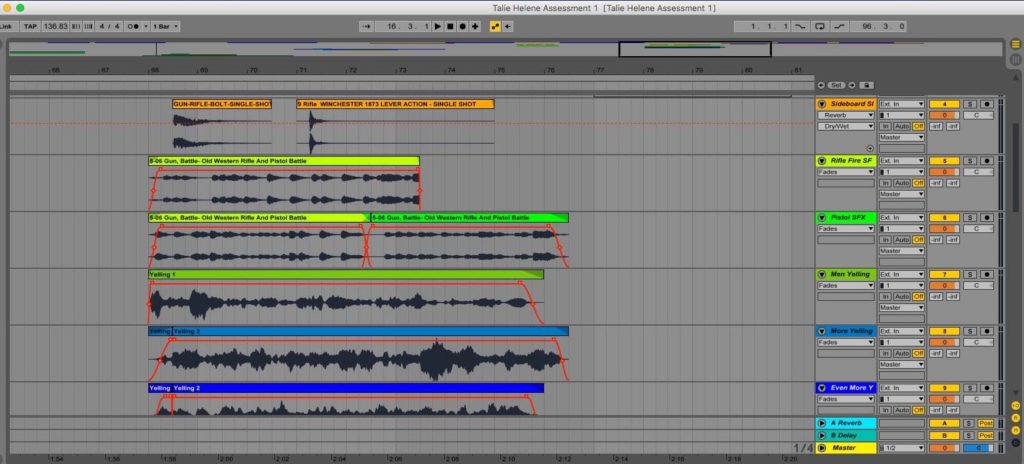
Ableton Screen Shot: Layered vocal elements of Men Shouting & Yelling location recordings, with SFX Library Gunshot Samples.
Both the Gun Shots (rifles and handguns) elements were created by layering numerous FX library samples, along with original sounds created by slamming the kitchen sideboard doors in my rental house – the regular cupboard and a metal enclosure which may have once housed ice (the house is circa 1920, and has many old fittings), recorded using a ZoomHN2 Handheld Digital Recorder with Built-In Microphone, with some reverb and EQ filtering.
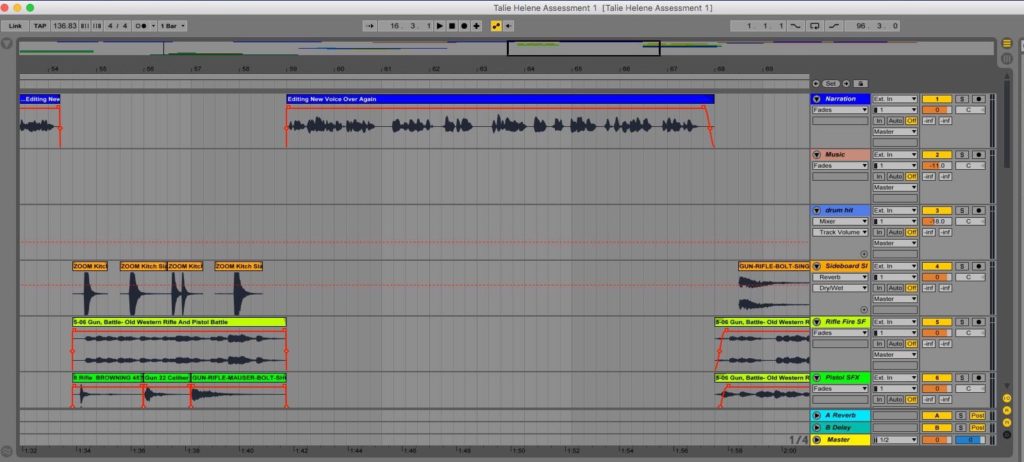
Ableton Screen Shot: Kitchen Sideboard Door Slams, layered with SFX Library Gunshot, and Voice Over element above.
I decided to do something a bit different than use the obvious steam train source of Puffing Billy. The Train Whistle was an original element I recorded on location at the Scoresby Steamfest using a Tascam DR-100MKII Linear PCM Recorder and a Sennheiser ME66/K6 Supercardiod Shotgun microphone. I was able to get very close to the source and ask the engine driver to pull the whistle for my recording.
The Steam Train Pistons Pumping was a combination of SFX Library Sample of a passing train with built-in panning effect and natural proximity effect, and original sounds layered together with volume automation, recorded on location on the grounds and in the engine sheds at Scoresby Steamfest (an annual event held by the Melbourne Steam Traction Engine Club), using a Tascam DR-100MKII Linear PCM Recorder and a Sennheiser ME66/K6 Supercardiod Shotgun microphone. I was able to get very close to many of the engines in the shed as they are fixed and quite safe to stand close to.
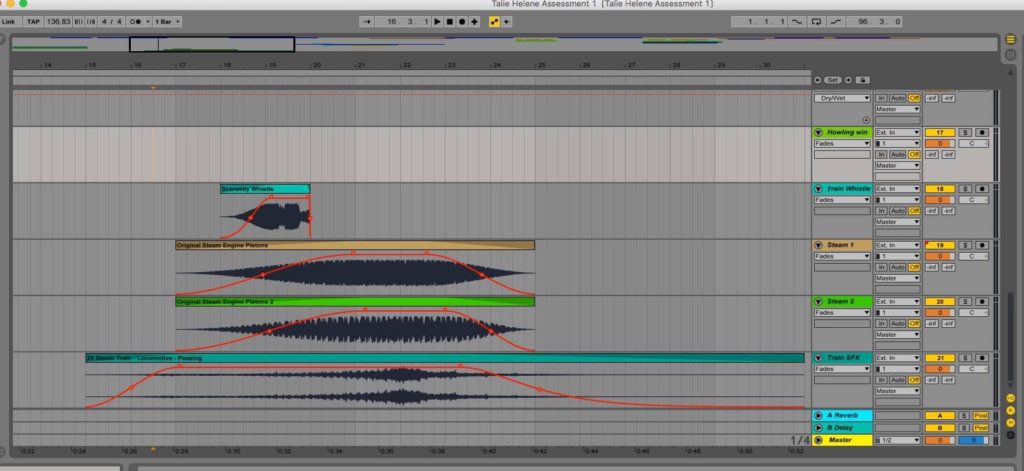
Ableton Session Screenshot: Layering of SFX Library Steam Train with two Steam Engine Location Recordings and a Steam Whistle Location Recording.
Due to the highly directional nature of the Sennheiser ME66/K6, it was possible to record sounds at SteamFest that were in close proximity to other loud sounds, as the directionality excluded a great deal of spill. For safety reasons I had the “auto level” function engaged at all times on the Tascam DR-100MKII Linear PCM Recorder, as I was monitoring with fully enclosed headphones and some of the sound sources were extremely loud, while others were not. The most problematic sources of spill were the PA announcements and the amplified country music artists at the market stage, who intruded on the vintage sound sources and were less directional due to amplification and speaker placement.
Processing, Editing & Mixing
I used three Digital Audio Workstation (DAW) environments for various tasks in this project. I recorded and edited the voice overs in Nuendo 8. I further edited the male voice over into element portions, and edited long location recordings and foley recordings to trim to required elements only in Pro Tools 12.
All audio elements were placed in Ableton Live 9. Some effects processing, and automation (panning, levels) was applied in Ableton.
I found in general my skills in Ableton Live 9 are very “newb”, and I had a lot of problems with not being familiar with Ableton specific features (such as Warp), as well as generally navigating and using the DAW. I still feel I have a poor grasp of the creative capacity and basic features of Ableton Live 9, which is why I applied (and was accepted) to attend the Operator short course in Ableton for women, trans and NGC people being held at Arts Centre Melbourne later this month; it is my hope that over the six weeks intro level course focused completely on Ableton operation, I will get the skills to go forward and make a more truly creative and competent use of Ableton in higher education studies.
Finished Project
You can listen to an MP3 of the finished Audio Tour here, in all its dubious glory. IMHO it needs to be re-balanced, as it had to be rough mixed in cans in Maclab during an arrangement class presentation, as the Ableton Edit Suites with Adam monitors were not functional, with Ableton not registered.
MP3: Audio Tour Project:
Ciao! Ciao!
Please feel free to leave a comment on this Blog Post. Thank You for labouring through reading or skimming this “virtual” Project Presentation. Now go outside and get some Vitamin D!
References
| ↑1, ↑2, ↑3 | Assessment 1 BRIEF, Created by Greg O’Shea, Martin Koszolko, February 2016, @Melbourne Polytechnic 2017. |
|---|---|
| ↑4 | https://www.neumann.com/?lang=en&id=current_microphones&cid=m149_description |
| ↑5 | Giang, Vivien. ‘How Unconscious Bias Is Affecting Our Ability To Listen’ Fast Company, 2016. https://www.fastcompany.com/3063218/how-unconscious-bias-is-affecting-our-ability-to-listen |
| ↑6 | https://en-us.sennheiser.com/directional-microphone-shotgun-film-broadcast-me-66 |
I am putting the “blog” portion of this website on hiatus while I write the first draft of a literary novel with the working title: ‘A Control Room of One’s Own’. It is a very different flavour of writing from this website, and best shrouded in mystery at this early stage of development.
You can keep tabs on my wordcount here:
I will be adding other music and production resources to this site, and you can always follow the Facebook page for some cool curated content – some music, some gender politics, and some fun, because none of those things are mutually exclusive!





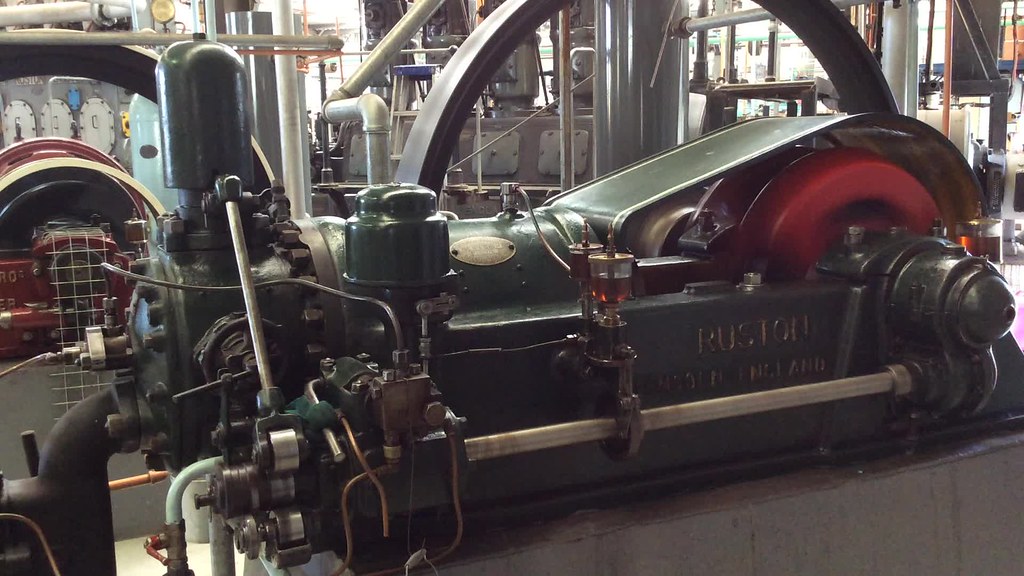
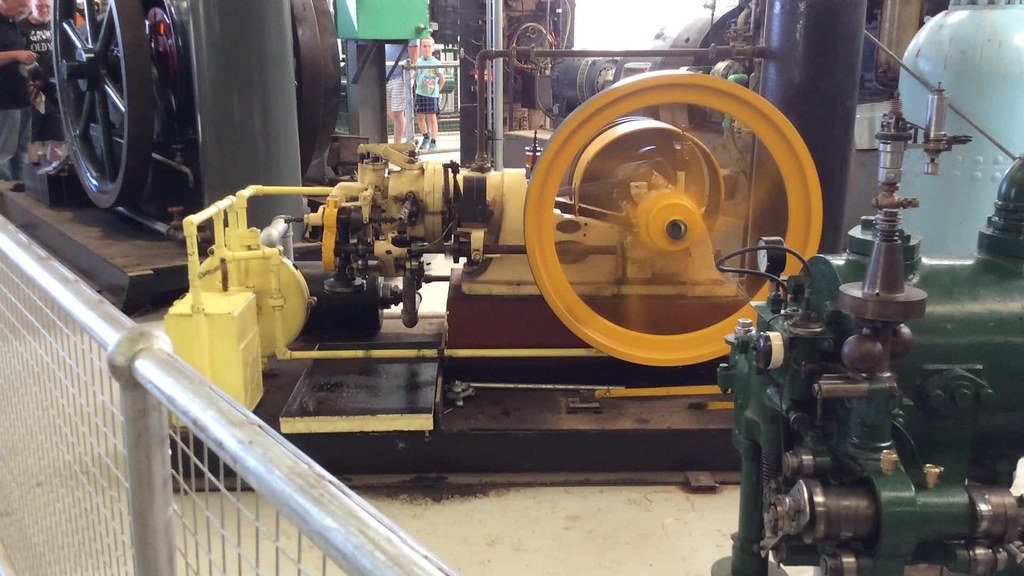
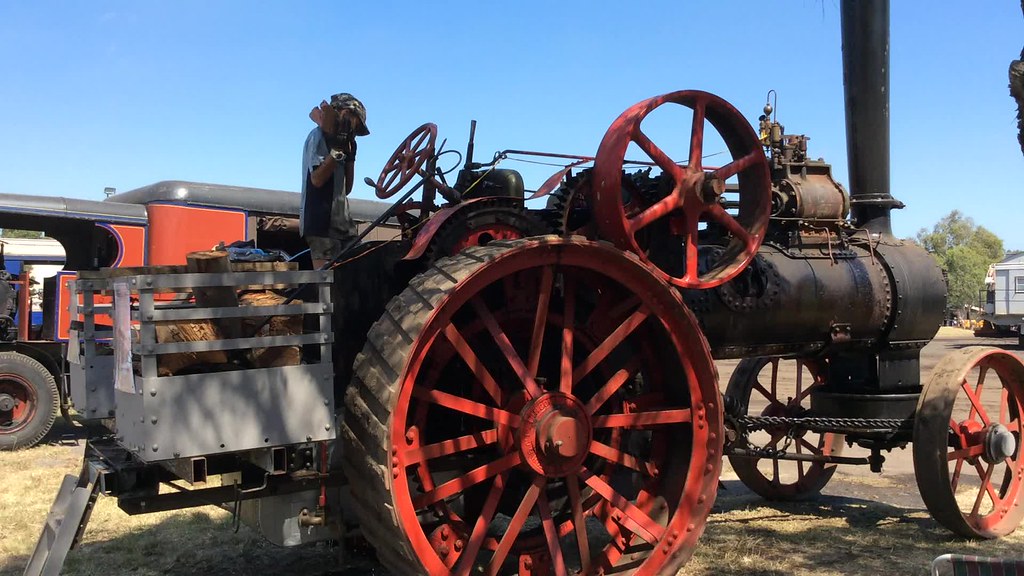
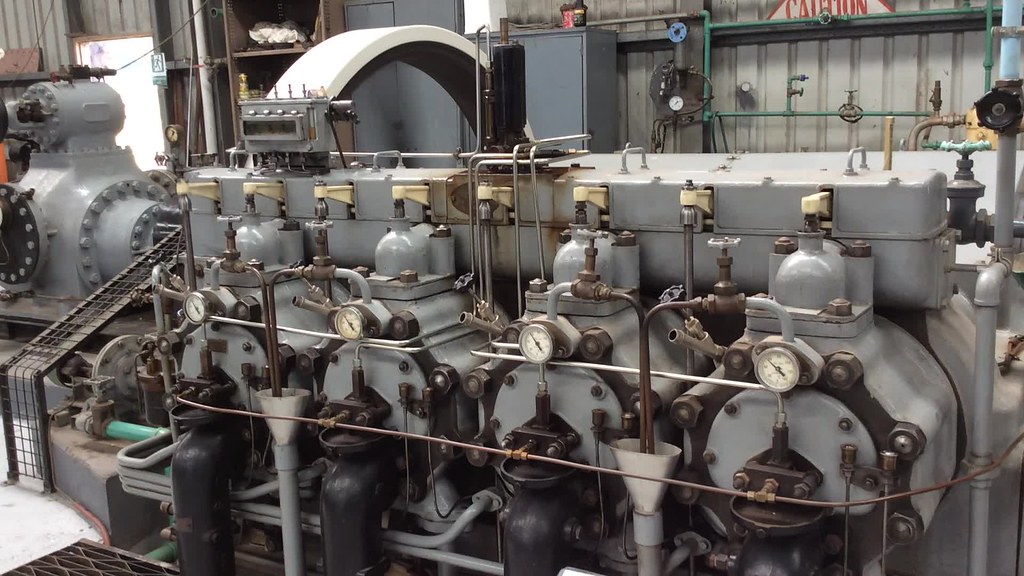
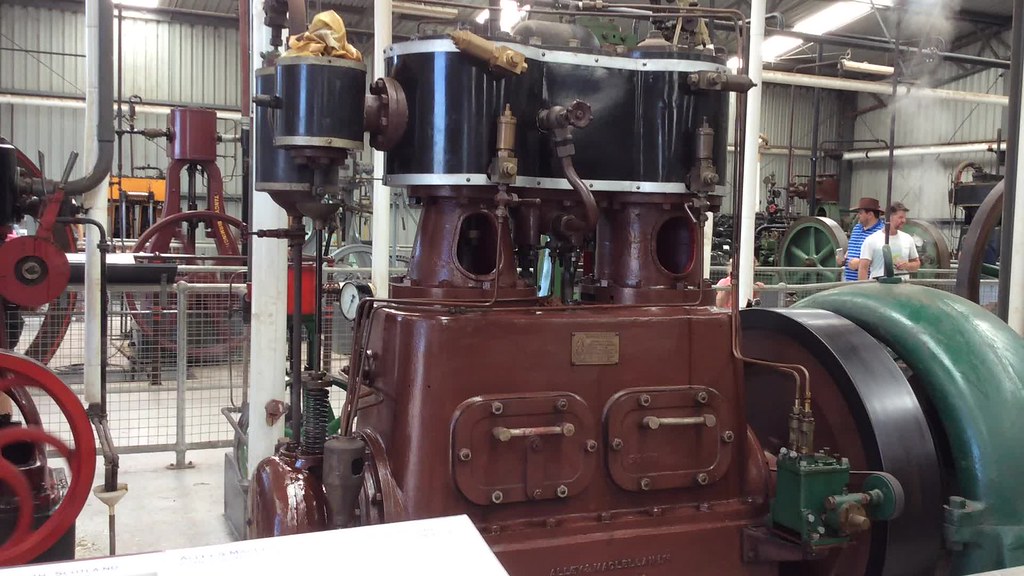


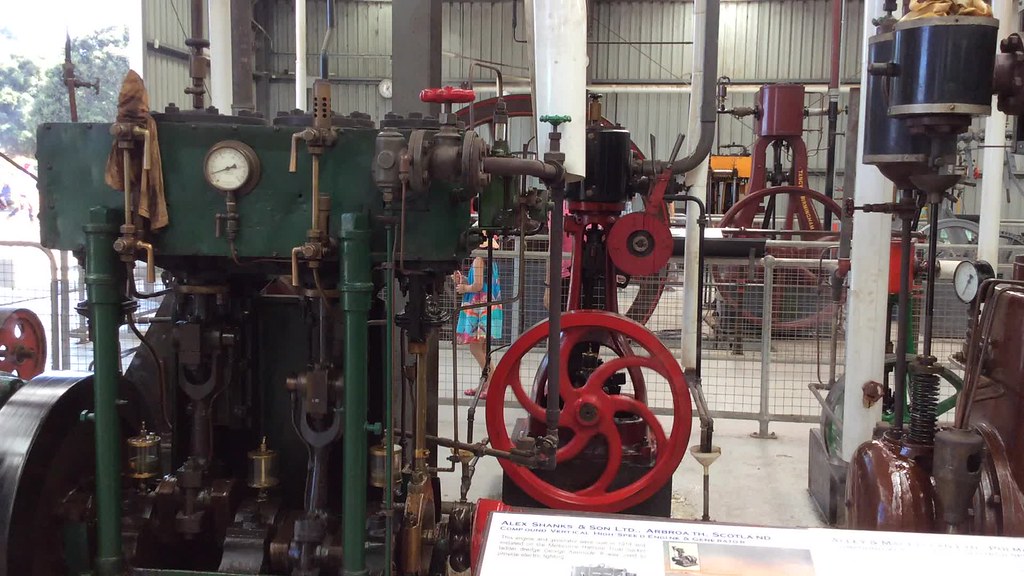
 You can find out more about my creative activities at
You can find out more about my creative activities at 
Recent Comments